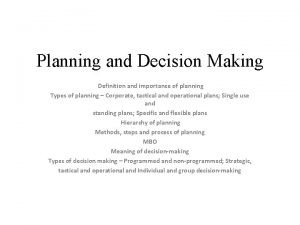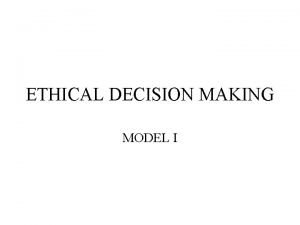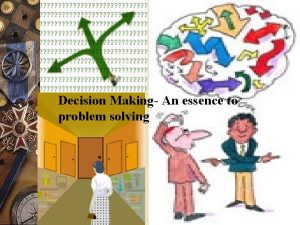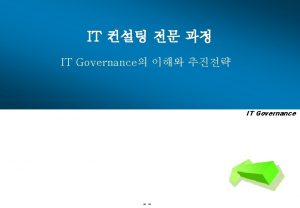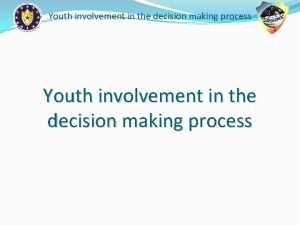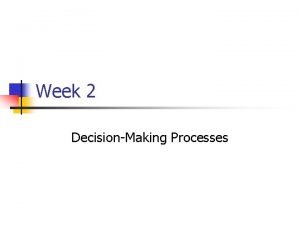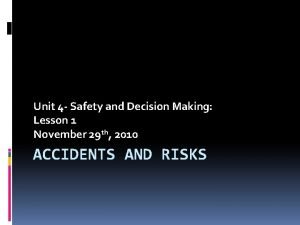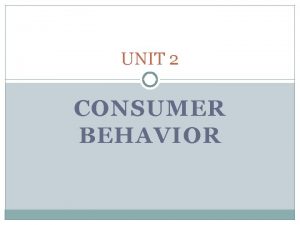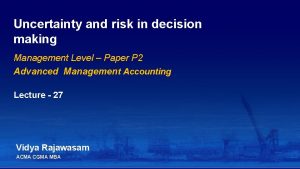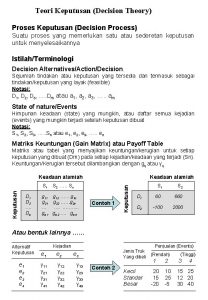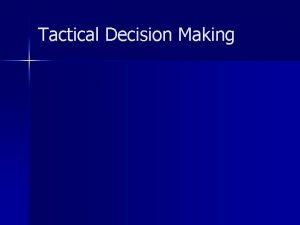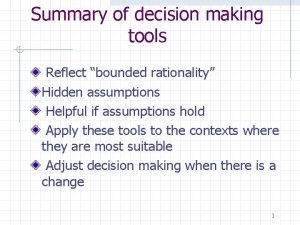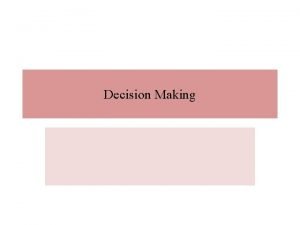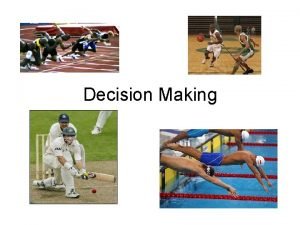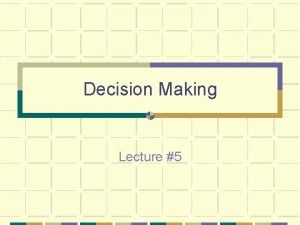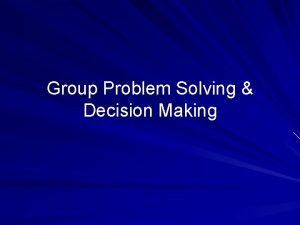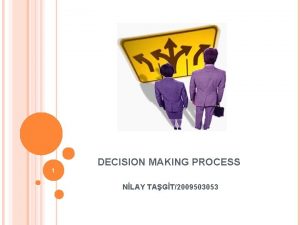DECISION MAKING CONTENTS Introduction Characteristics Nature of Decision






























- Slides: 30

DECISION MAKING

CONTENTS § Introduction § Characteristics § Nature of Decision Making § Steps involved in decision making § Basis for decision making § Decision making conditions § Types of decisions §Techniques of Decision Making § Modern Techniques § Traditional Techniques § Decision-Making Behaviour Models § Group Decision Making § Techniques of Group Decision-Making

What is Decision Making? • Decision Making is the act of choosing one alternative from among a set of alternatives. • We have to first decide that a decision has to be made and then secondly identify a set o feasible alternatives before we select one.

According to Peter Drucker, ”Whatever a Manager does, he does through Decision Making. . !”

Characteristics üDecision making implies choice üContinuous process üMental/Intellectua l Activity üAimed to achieve organizational

Nature of Decision-Making A decision is always related to some problem, difficulty or conflict. ü There always differences of opinions, judgments, etc. ü A decision need some sort of prediction for the future. ü Sometimes Decisions are influenced by adopting the follow ü

Steps involved in Decision-Making

� Intuition � Facts � Experience � Considered Opinions � Operations Research � Linear Programming

Decision Making Conditions ● Certainty ● People are reasonably sure about what will happen when they take a decision. ● Manager makes decision under such situations at different times with the same results. ● Risk ● Factual information may exist but it may b insufficient. ● Future outcomes associated with each alternative are subject to chance. ● Uncertainty ● Manager know which goals they wish to achieve.

Types of Decisions 1. Programmed and Non. Programmed Decisions 2. Strategic and Tactical Decisions 3. Individual and Group Decisions

Programmed Decisions �For Solving day to day and routine problems. �Rules & procedures are described for taking these decisions. �Remain consistent for longer period. �For solving both simple & complex problems. Non-Programmed Decisions �For solving non-repetitive, tactical or unique problems. �Every decision will have to be taken separately by analyzing & evaluating. �Every decision is different & no consistency. �For solving complex problems. �Requires judgments.

Strategic Decision �Taken at top management. �Decisions have long term implications. �Related to growth, development & profitability of the organization. � More judgment & skill required. Tactical Decision � Taken at lower level of management. � Decisions have short term implications. � Concerned with simple, routine & repetitive problems. � Taken with pre-determined rules & procedures. � Less judgment.

Individual Decision Group Decision � One person only takes Decision. � Decisions are programmed one. � Less important. � Taken by sole proprietor when the problem is of routine nature. �Taken by group of persons. �Taken after thorough discussions.

TECHNIQUES OF DECISION MAKING Traditional techniques Modern techniques

Traditional Techniques of Decision Making A. Decision-Making for programmed Decisions i. ii. Standard Procedures and Rules Organizational Structure B. Decision-Making for Non -Programmed Decisions Linear Programming ii. Probability Theory iii. Game Theory iv. Queing Theory v. Network Techniques i.

MODERN TECHNIQUES OF DECISION MAKING i) Heuristic Techniques ii) Participative Decision Making

DECISION MAKING BEHAVIOUR MODELS 1. RATIONAL OR ‘ECONOMIC MAN MODEL’ - defines rationality in terms of objective and intelligent action. It is characterized by behavioural nexus between ends and means. HARBERT A. SIMON • FEATURES - i) Systematic , logical and full of reasoning approach ii) Manager is supposed to be objective iii) Managers should try to reach goals with positive attitude iv) Understanding of existing environment

2. BEHAVIOURAL MODEL OR BOUNDED RATIONALITY OR ADMINISTRATIVE MAN HARBERT SIMON has proposed a theory of ‘bounded rationality’. This theory states that real life decision maker must cope up with inadequate information about nature of the problem and its solution. The norm of rationality is bounded by many limitations and , therefore, the concept is known as‘ bonded rationality’. • The managers rationality is bounded by the following major limitations: I)Lack of information ii) Time constraint iii) Conflicting objectives iv) environmental uncertainties

GROUP DECISION MAKING • ASPECTS OF GROUP DECISION MAKING - i) Risk shifting phenomenon ii) Group think

Techniques of Group Decision Making 1. Brainstorming 2. The Delphi Technique 3. Nominal Group Technique 4. Synectics

Brainstorming The technique of brainstorming was developed by Alex F. Osborn to help to bring creative ideas in the field of advertising. LIMITATIONS: -Costly -Time consuming -superficial ideas

The Delphi technique named after the Oracle at Delphi in ancient Greece was developed by N. C. Dalkey and his associates in 1950 at Rand Corporation’s Think Tank.

Nominal group technique The Technique follows a highly structured process and tries to integrate creative thinking through group interaction for solving orgnisational problems.

Synetics This technique of decision –making was developed by William J. J. Gordon in 1944. The Synectic process involves(a) making the strange familiar, (b) making the familiar strange

ADVANTAGES OF GROUP DECISION MAKING 1. more ideas and information 2. more acceptability and commitment 3. more creativity 4. more satisfied

1. wasting more time and energy 2. some members dominate and others may not express their views 3. costly 4. conflicts

Administrative Problems In Decision Making 1. 2. 3. 4. 5. Correctness of Decisions Timing of Decisions Effective communication of Decisions Participation in Decision-Making Implementation of Decision

CHALLENGES FOR DECISION MAKERS 1. Multiple Criteria 2. Risk and Uncertainty 3. Long term Implications 4. Inputs of different Sections 5. Pooled Decision Making

Any queries? ? . .

"Good Decisions come from experience. Experience comes from making bad decisions. " - Mark Twain
 Planning and decision making
Planning and decision making No decision snap decision responsible decision
No decision snap decision responsible decision Financial decision
Financial decision Introduction to ethical decision making
Introduction to ethical decision making Scope of decision making
Scope of decision making Characteristics of decision making
Characteristics of decision making Nature table of contents
Nature table of contents Contents introduction
Contents introduction Is making inference simply making a guess
Is making inference simply making a guess War making and state making as organized crime
War making and state making as organized crime Nature and nature's laws lay hid in night meaning
Nature and nature's laws lay hid in night meaning Determinace lidské psychiky
Determinace lidské psychiky Involvement decision making
Involvement decision making Ethical assessment screen
Ethical assessment screen Systematic decision making process
Systematic decision making process What doing our country
What doing our country Using recursion in models and decision making
Using recursion in models and decision making Using recursion in models and decision making sheet 3
Using recursion in models and decision making sheet 3 Defining moments
Defining moments Unit 4 lesson 1 decision making
Unit 4 lesson 1 decision making How to improve marketing performance
How to improve marketing performance Types of decision making
Types of decision making Higher business corporate culture
Higher business corporate culture Decision making unit example
Decision making unit example Unstructured decision making
Unstructured decision making Research
Research Cdm decision making model
Cdm decision making model Contoh soal decision tree
Contoh soal decision tree Tactical decision making adalah
Tactical decision making adalah What is the dare decision making model
What is the dare decision making model Bounded rationality
Bounded rationality
